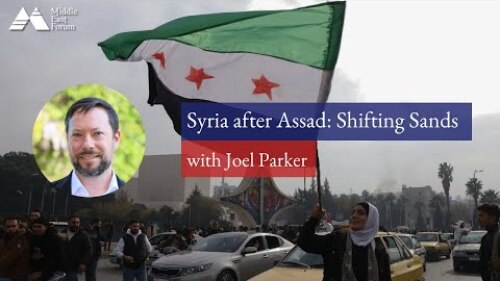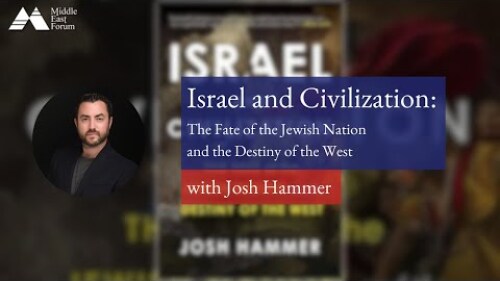In a Middle East Forum (MEF)/American Jewish University (AJU) May 20 podcast (video), AJU’s Rick Richman moderated the second of a seven-part series of interviews titled “Israel’s Seven-Front War: Part Two: Israel’s West Bank.”
Guest speaker: Gregg Roman, director of the Middle East Forum. The following summarizes his comments:
The Israel Defense Forces (IDF) are facing “no less a powder keg” in Israel’s West Bank than in its fight on the six other fronts. Israeli intelligence reports that Iran arms and supports Hamas, Palestinian Islamic Jihad (PIJ), and assorted terror groups in the West Bank. The result: an “unprecedented escalation in violence and military action” there since Israel launched its Gaza war in response to Hamas’s October 7 invasion.
The Israel Defense Forces (IDF) are facing “no less a powder keg” in Israel’s West Bank than in its fight on the six other fronts.
By traversing Iraq, Syria, Lebanon, and Jordan into Israel, Iran’s smuggling network transports weapons into the West Bank. In the past eight months, Israeli security forces have intercepted 1,200 weapon shipments, thousands of assault rifles and rocket-propelled grenades (RPGs), over a thousand anti-tank missiles, and more than 500,000 rounds of ammunition.
In March 2024, an attempt by the Islamic Revolutionary Guard Corps (IRGC) to smuggle 20 tons of explosives and weapons into the West Bank was thwarted by a joint counterterrorism operation of the IDF and the Shin Bet, Israel’s internal security service. The regime’s “Iranian Ring of Fire” strategy is meant to “encircle Israel with dangerous actors.” The mullahs have poured more than $200 million into Hamas and PIJ in an effort to increase recruitment, harden their positions, and “carry out increasingly sophisticated attacks against Israel.”
Israel has responded to over 150 terror attacks that have wounded more than 300 since October 2023 with “new weapons being used to try to mitigate these terror attacks and even the use of helicopter and airstrikes.” In addition, the IDF has thwarted more than 200 planned attacks. Israeli intelligence sources suggest Hamas and PIJ have “over 15,000 fighters under arms and tens of thousands more weapons at their disposal.” Over the past eight months, “Israel has conducted more than 3,000 raids and arrest operations targeting Hamas, IJ, and terrorists from the Fatah faction,” which is controlled by Mahmoud Abbas, aka Abu Mazen, the elderly and ailing president of the Palestinian Authority (PA).
Any succession process Abbas would involve a leadership struggle between multiple Fatah leaders eyeing his spot. Palestinian opinion polls favor Hamas to head the PA if the international community’s preference for elections were held today in the West Bank and Gaza.
The PA did not join the October 7 attacks because Abbas “did not see it in the PA’s interest,” nor in his own interest, as it would have disrupted his “fiefdom of Ramallah.” Moreover, the decentralized leadership of West Bank terror groups makes it far easier for Israel, with its extensive intelligence network, to deploy its forces in eight Palestinian civilian centers from which terrorists operate, as well as in the 65 percent of the West Bank where Israelis have “freedom of movement.” Contrast this with Gaza, where Yahya Sinwar commands a “central government structure” of forces from his bunker.
Israeli civilians west of the Green Line are increasing their political pressure on the government to resolve ongoing attacks “because Palestinian terrorism knows no borders.”
Israel’s campaign of “high level airstrikes” succeeded in degrading the West Bank terror infrastructure to the point where Hamas and PIJ have “lost over 30 percent of their fighters and 40 percent of their arsenal” since the start of the Gaza War. However, threats continue “with the IDF intercepting an average of 20 weapon shipments and thwarting 10 planned attacks each month.” Even with Israel’s West Bank security measures protecting its citizens and disrupting terror networks, the violence has taken a toll on both sides. Thus, the Palestinian economy has contracted by 20 percent, while the estimated cost of Israel’s military campaign is $2 billion.
The threat of shooting attacks and attempted bombings is high. Israeli civilians west of the Green Line are increasing their political pressure on the government to resolve ongoing attacks “because Palestinian terrorism knows no borders.” For now, there is “low intensity conflict with a deterrent-based strategy.”
While Israel prefers the continuation of security cooperation with the PA, “the long game” scenario for Israel is to see a “devolution in terms of their [PA] civil rule and of their politics, and to rebuild it with a partner who would be willing to live side by side with Israel, somewhat hesitantly.” That can only happen if the “militant threat that exists east of the Green Line” is eradicated. The key point of Middle East Forum’s Israel Victory Project (IVP) is that a resolution will only occur after Palestinian rejectionism of Israel ends. First, recognition of Israel’s “right to exist as a state,” then negotiation. First victory, then peace.




